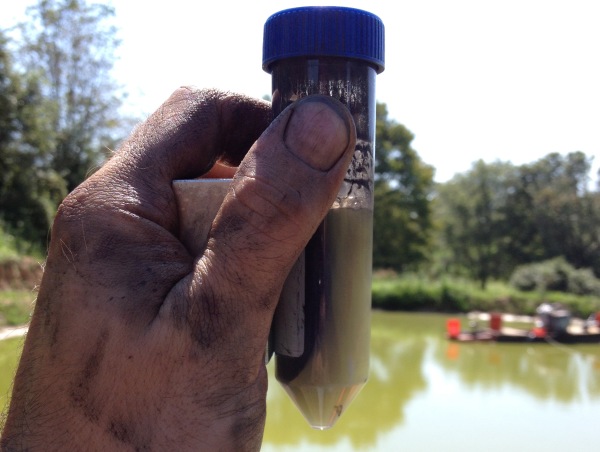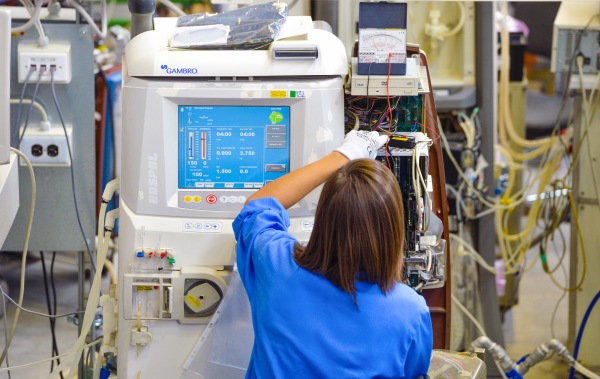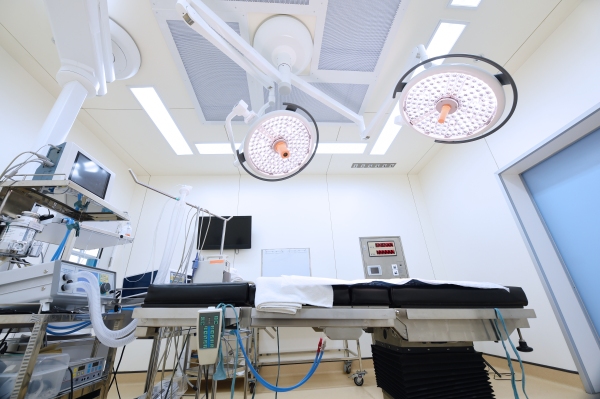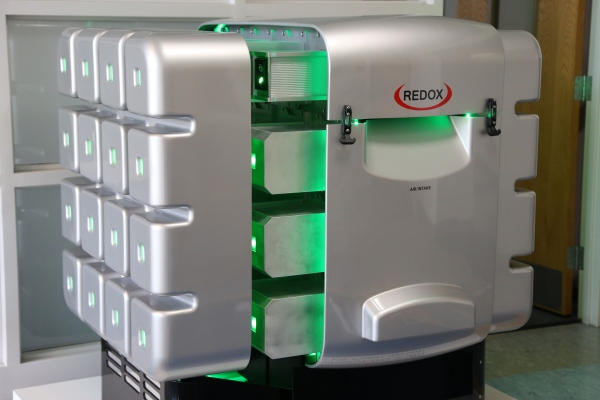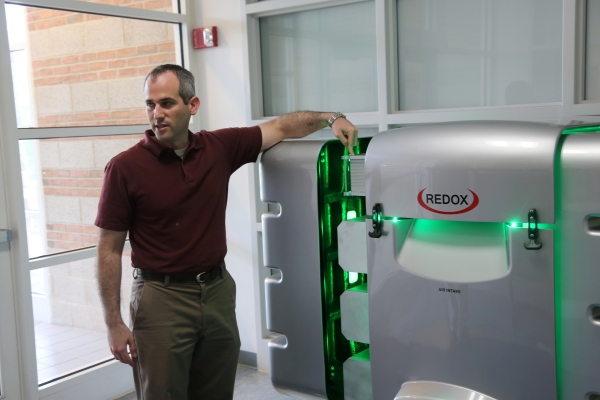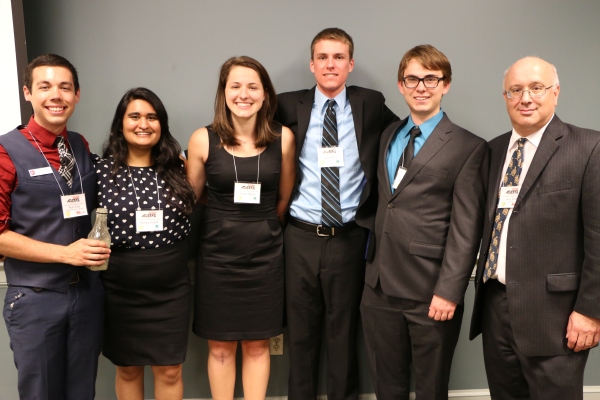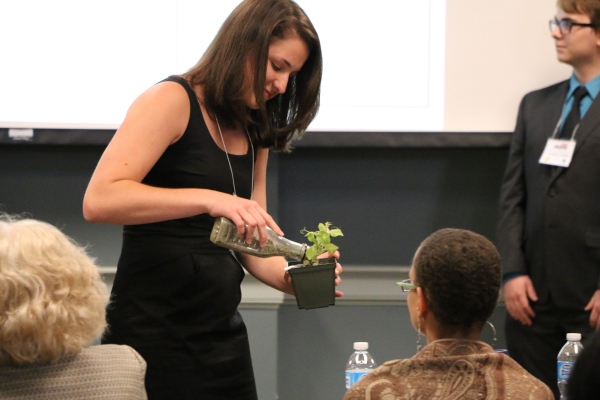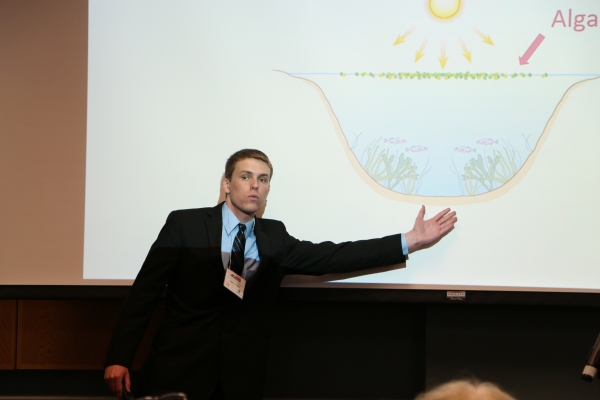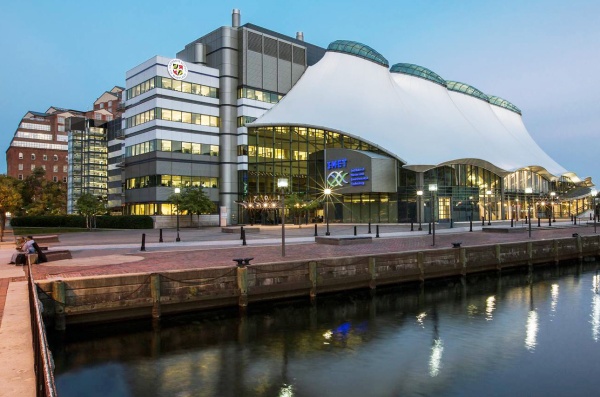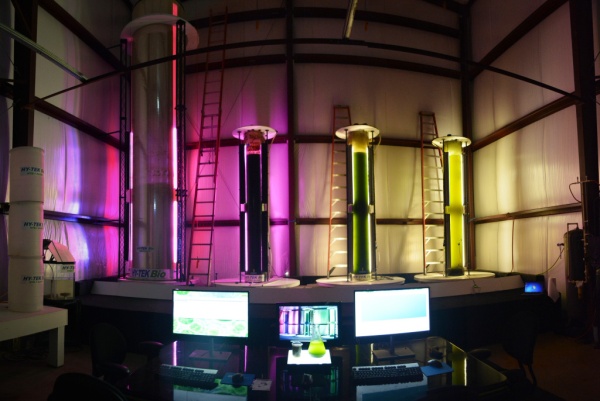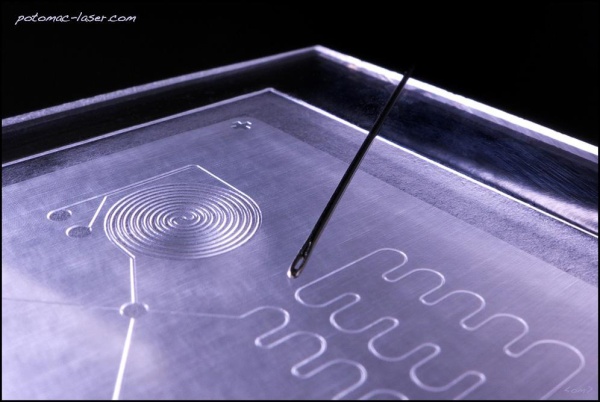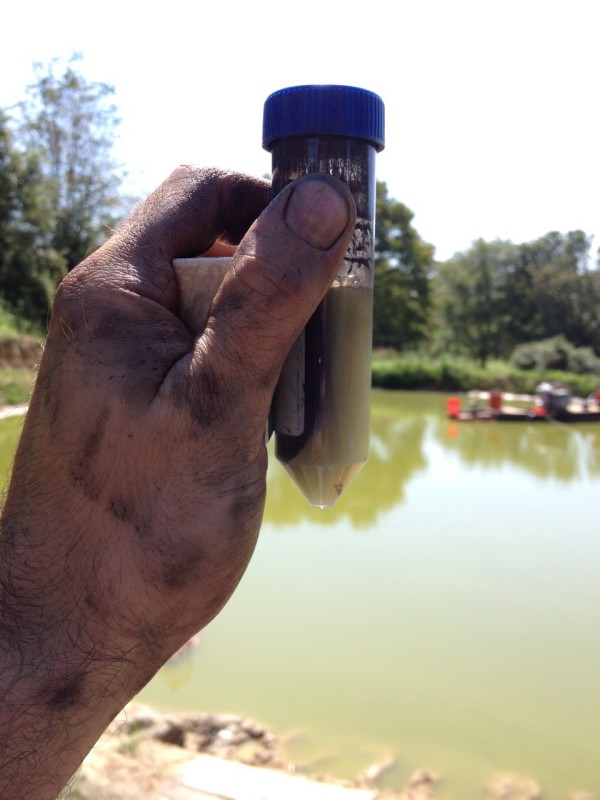
Pictured: algae collected from the pond in the background by Manta Biofuel LLC. The concentrated algae is converted into renewable crude oil. Manta Biofuel manufactures renewable, carbon neutral crude oil from algae that is cost competitive with fossil crude oil. Through the Maryland Industrial Partnerships (MIPS) Program, Manta Biofuel works with Russell Hill, professor and director of the Institute of Marine and Environmental Technology, to determine the quality of oil that will be produced from varying types of algae blooms.
Four aquaculture projects highlight round
The Maryland Industrial Partnerships (MIPS) program, an initiative of the Maryland Technology Enterprise Institute (Mtech) in the A. James Clark School of Engineering at the University of Maryland, has approved 15 collaborative technology product development projects teaming Maryland companies with university researchers, program officials announce today.
A technology acceleration program, MIPS grants money, combined with company funds, to faculty engaged in each project.
This round of MIPS grants, worth $3.3 million, combines $1.3 million from MIPS and $2 million in cash and in-kind contributions from participating companies. The Maryland Department of Natural Resources and the Environmental Protection Agency provided additional funding.
Four projects focus on aquaculture in Maryland. Two involve automated oyster production, while a third enhances oyster aquaculture by co-harvesting algae as an additional product. The fourth creates a high-value fish feed from Maryland crops.
The additional 11 projects include: genomic treatment for brain trauma, on-site narcotic detection, unmanned surface vessel control system, electricity generator driven by natural gas, cord blood collection device, chronic disease mobile platform, pathogen detection system, advanced travel website and mobile application, assessment tool for violent youth, speaking enhancement software, and a system that produces crude oil from algal blooms.
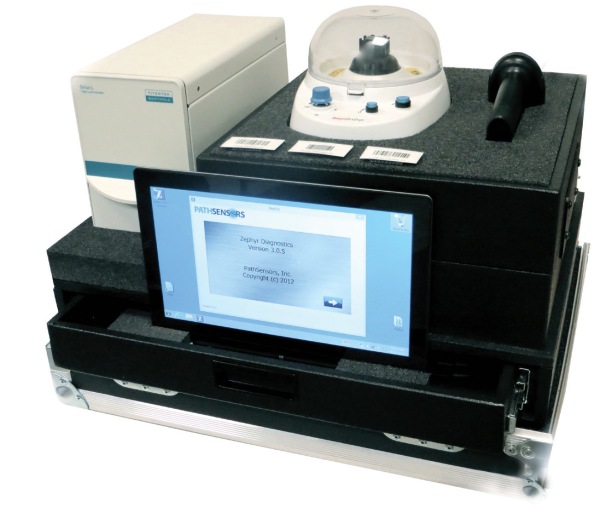
PathSensors Inc. develops pathogen detection systems (pictured) for bio-security and agriculture/food processing applications. The company’s products deliver rapid detection of more than 25 pathogens at previously unattainable levels of speed and sensitivity. Through the MIPS program, PathSensors collaborates with Dan Schulze, associate professor, department of microbiology and immunology, University of Maryland, Baltimore, to develop a universal biosensor system that enables the company to rapidly add new pathogens to its detection platform.
This round of funding connects faculty with 13 startups and two small companies. Six companies are based in the Baltimore area, three are from Maryland’s Eastern Shore, two are in College Park and one each is in southern Maryland (Hollywood), western Maryland (McHenry), Rockville and Columbia.
The approved projects, along with the combined total funding for each, include:
Autonomy Engine LLC, based in Marriottsville, develops software that predicts how listeners will perceive an individual’s speaking style. The company collaborates with Ellyn Sheffield, a research professor in the department of psychology at Towson University, to enhance the software. ($361,199)
CARE-2 LLC, based in Salisbury, develops an assessment tool to evaluate and recommend treatment for youth at risk for behaving violently. The company, through Eastern Shore Psychological Services LLC, works with Marvin Tossey, professor, social work department, Salisbury University, to analyze and improve the predictive validity of the CARE-2 assessment tool. ($250,271)
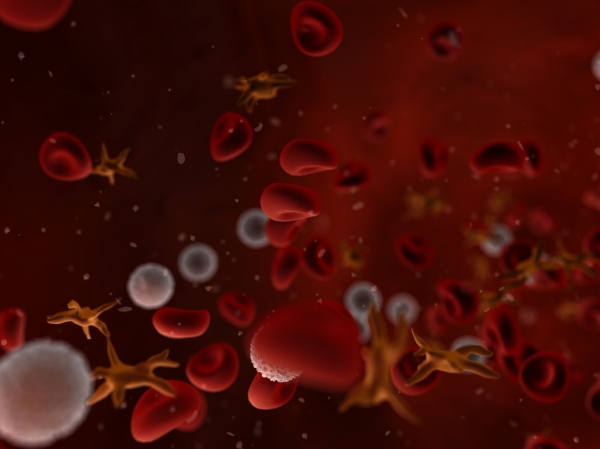
Traumatic brain injury (TBI) is a serious public health problem in the United States, with 2.5 million TBI’s occurring in 2010 alone. Cellphire Inc. plans to deliver microRNA in blood platelets, which move quickly to the site of a brain injury, delivering therapeutic (healing) agents.
Cellphire Inc., based in Rockville, is developing cell stabilization technologies that also have application in the delivery of therapeutics and labeled reagents in the diagnosis of traumatic brain injuries. The company collaborates with Bogdan Stoica, assistant professor, department of anesthesiology, University of Maryland, Baltimore, to refine and test the efficacy of the company’s technology for treating brain trauma. ($135,165)
Diagnostic anSERS Inc., based in College Park, develops low-cost sensors that detect trace chemicals using surface-enhanced Raman spectroscopy (SERS). The company works with Ian White, associate professor, Fischell Department of Bioengineering, University of Maryland, to create a field-optimized narcotics sensor for use in law enforcement. ($135,000)
Hollywood Oyster Company LLC, based in Hollywood, is one of the largest oyster farms in Maryland. The company works with Patrick Kangas, associate professor, department of environmental science and technology, University of Maryland, to develop methods for scaling up macroalgae (seaweed) aquaculture to be grown in conjunction with oysters, both as a commercial product and to improve water quality in the Chesapeake Bay. ($157,880)
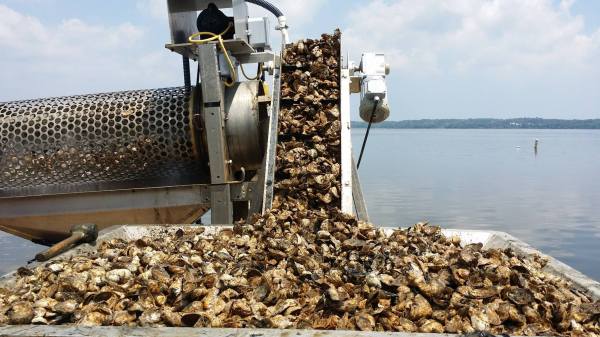
Pictured: Oysters ready to be processed for sale or re-planted in the Chesapeake Bay by the Hollywood Oyster Company.
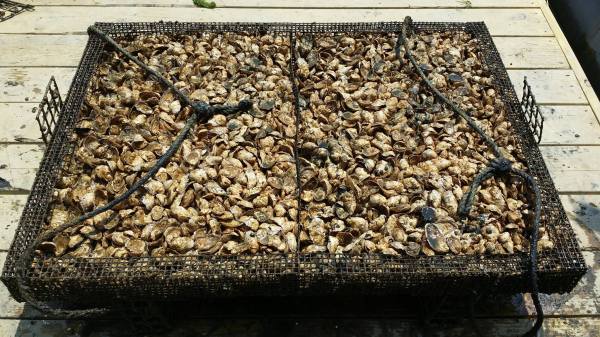
Hollywood’s oysters are grown in traps in the Bay (pictured). If macroalgae (seaweed) is grown on a commercial scale near oyster farms, it could serve as a biofilter to remove excess nutrients in the Bay, and can be harvested for marketable food products.
Hoopers Island Oyster Aquaculture Company LLC, based in Fishing Creek, produces high-quality half-shell oysters and the equipment needed to support aquaculture in Maryland. The company works with Yang Tao, professor, Fischell Department of Bioengineering, University of Maryland, to develop a laser 3D machine vision system that sorts Chesapeake Bay-cultured oysters into quality grades. ($511,000)
Hyperion Technologies LLC, based in College Park, provides game-changing engineering services to civilian and defense clients, specializing in robotic control. The company works with S.K. Gupta, professor, department of mechanical engineering, University of Maryland, to develop an autonomous unmanned surface vehicle (USV) control system for applications such as military surveillance, environmental monitoring, off-shore oil platform inspection and search and rescue. ($218,800)
Manta Biofuel LLC, based in Reisterstown, manufactures renewable, carbon neutral crude oil from algae at a cost that is competitive with fossil crude oil. The company collaborates with Russell Hill, professor and director of the Institute of Marine and Environmental Technology, University of Maryland Center for Environmental Science, to determine the quality of oil that will be produced from varying types of algae blooms. ($332,274)
Metompkin Seafood Inc., based in Crisfield, distributes a variety of seafood products in the Chesapeake Bay region. The company works with Donald Meritt, principal agent, Horn Point Laboratory, University of Maryland Center for Environmental Science, to develop a high-volume, spat-on-shell oyster production system based on remote setting technology. ($238,676)
PathSensors Inc., based in Baltimore, is a biotechnology and environmental testing company developing pathogen detection systems for bio-security and agriculture/food processing applications. PathSensors collaborates with Dan Schulze, associate professor, department of microbiology and immunology, University of Maryland, Baltimore, to develop a universal biosensor system that enables the company to rapidly add new pathogens to its detection platform. ($136,469)
Plant Sensory Systems LLC, based in Baltimore, develops technologies that improve agricultural performance and reduce negative environmental impact. The company works with Allen Place, professor, University of Maryland Center for Environmental Science, to produce a plant-based aquafeed with low-leaching taurine, a compound required for the development and growth of farmed fish and shellfish. ($135,950)
Silicon Travel LLC, based in McHenry, provides property management companies and their homeowners with quality Internet access and tech support. The company collaborates with George Rinard, professor and chair, department of computer science & information technologies, Frostburg State University, to enhance the company’s travel website with an itinerary tool and accompanying mobile application. ($162,970)
Soony Systems Inc., based in Baltimore, is an R&D start-up developing Gas-Tricity, a 1-2 kW combined heat-to-power home generator unit driven by natural gas. The company collaborates with Christopher Cadou, associate professor, department of aerospace engineering, University of Maryland, to develop an experimentally validated model of the Gas-Tricity engine cycle and design a working prototype. ($200,000)
TheraCord LLC, based in Baltimore, develops a novel cord blood collection device that could exponentially increase yield at a lower cost than existing solutions. The company works with Tami Kingsbury, assistant professor, department of physiology, University of Maryland, Baltimore, to optimize its perfusion process, de-risk key regulatory concerns and propel the technology towards becoming the new gold standard for cord blood collection. ($140,160)
Vheda Health Corporation, based in Columbia, simplifies disease management operations by automating care plan adherence with a mobile intervention platform that reduces acute events for high-cost, chronic disease populations. The company collaborates with Gordon Gao, associate professor, department of decision, operations & information technologies and Center for Health Information and Decision Systems (CHIDS), University of Maryland, College Park, to enhance the effectiveness of Vheda Health’s product and establish the value of Vheda Health in the management of chronic conditions such as diabetes. ($255,172)
Projects are subject to final contract negotiations.
This is the 55th round of MIPS grants. The program has supported research projects with more than 500 different Maryland companies since 1987.
MIPS-aided commercial products have generated more than $30.2 billion in revenue, added over 6,600 jobs to the state and contributed to successful products such as Martek Biosciences’ nutritional oils, Hughes Communications’ HughesNet™, MedImmune’s Synagis®, Black & Decker’s Bullet® Speed Tip Masonry Drill Bit, WellDoc’s mobile diabetes management platform, and CSA Medical’s diseased-tissue ablation platform.
For information about the historical economic impact of the MIPS program, an independent study titled “An Analysis of the Impacts of MIPS Program Spending and the Commercialization of MIPS Funded Projects on the State of Maryland,” by Richard Clinch, from the Jacob France Institute at the University of Baltimore, is available online.

